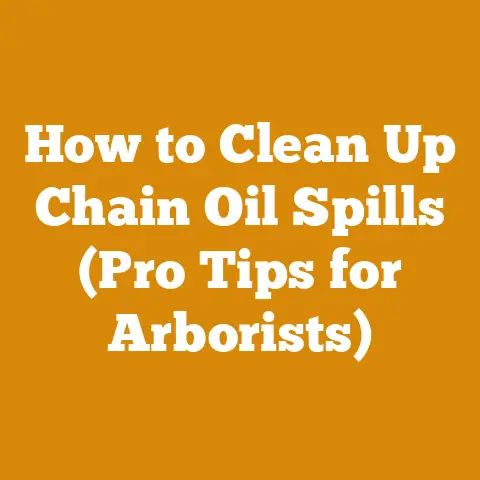Stihl 056 AV Magnum 2 Chainsaw Tips (5 Pro Maintenance Hacks)
WARNING: Working with chainsaws, especially a powerful beast like the Stihl 056 AV Magnum 2, demands respect and a healthy dose of caution.
This article contains information based on my personal experience and research.
Always consult your chainsaw’s manual and adhere to all safety regulations before performing any maintenance or operation.
Improper handling can lead to serious injury or even death.
Wear appropriate personal protective equipment (PPE), including eye protection, hearing protection, gloves, and chainsaw chaps.
Hello fellow wood enthusiasts!
The Stihl 056 AV Magnum 2.
Just the name conjures images of towering trees falling with a satisfying roar.
This chainsaw isn’t just a tool; it’s a legend.
I’ve spent countless hours alongside mine, felling trees, bucking logs, and preparing firewood.
It’s a workhorse, no doubt, but like any high-performance machine, it demands proper care and attention to truly shine.
In this article, I’m going to share five pro maintenance hacks that will keep your Stihl 056 AV Magnum 2 running strong for years to come.
These aren’t just generic tips; they’re the lessons I’ve learned through trial and error, the “secrets” I’ve picked up from seasoned loggers, and the insights gleaned from countless hours of tinkering in my own workshop.
Key Takeaways:
- Fuel is Paramount: Using the right fuel mixture and storing it properly is crucial for engine longevity.
- Air Filter Vigilance: A clean air filter prevents engine damage and ensures optimal performance.
- Chain Sharpening Mastery: A sharp chain is safer, more efficient, and reduces strain on the saw.
- Bar and Chain Oiling: Proper lubrication extends the life of your bar and chain and prevents costly damage.
- Regular Inspection and Cleaning: Catching small problems early prevents major breakdowns.
So, grab your tools, put on your safety gear, and let’s dive into the world of Stihl 056 AV Magnum 2 maintenance!
The Stihl 056 AV Magnum 2: A Logging Legend
Before we get into the nitty-gritty of maintenance, let’s take a moment to appreciate the legacy of the Stihl 056 AV Magnum 2.
Introduced in the late 1970s, this saw quickly became a favorite among professional loggers and serious firewood cutters.
Its robust construction, powerful engine, and reliable performance made it a force to be reckoned with in the woods.
Why was the 056 AV Magnum 2 so popular?
- Power: Its displacement engine delivered ample power for felling large trees and tackling tough hardwoods.
- Durability: Built with high-quality components, the 056 AV Magnum 2 was designed to withstand the rigors of daily use.
- Reliability: With proper maintenance, these saws could run for years, even decades, with minimal issues.
Even today, well-maintained 056 AV Magnum 2 chainsaws are highly sought after by enthusiasts who appreciate their power and reliability.
However, due to their age, proper maintenance is more critical than ever.
Parts can be harder to find, and neglect can quickly lead to costly repairs.
Hack #1: Fueling the Beast – The Right Mix and Storage
Fuel is the lifeblood of any two-stroke engine, and the Stihl 056 AV Magnum 2 is no exception.
Using the wrong fuel mixture or storing it improperly can lead to a host of problems, including poor performance, engine damage, and even complete failure.
The Correct Fuel Mixture:
Stihl recommends a fuel-to-oil ratio of 50:1 for the 056 AV Magnum 2.
This means 50 parts gasoline to 1 part two-stroke oil.
Using the correct ratio is critical for proper lubrication of the engine’s internal components.
My Personal Recommendation:
While Stihl recommends 50:1, I’ve found that using a slightly richer mixture of 40:1 can provide added protection, especially when running the saw under heavy load or in hot weather.
This is a personal preference based on my experience, and it’s something you should consider based on your own operating conditions.
Why is the correct mixture so important?
- Lubrication: Two-stroke oil provides essential lubrication to the piston, cylinder, and crankshaft.
Too little oil can lead to excessive wear and eventual seizure. - Cooling: The oil in the fuel mixture also helps to cool the engine.
A lean mixture can cause the engine to overheat, leading to damage. - Combustion: The fuel mixture affects the combustion process.
An incorrect mixture can result in poor performance, increased emissions, and potential engine damage.
Choosing the Right Gasoline:
- Octane Rating: Use gasoline with an octane rating of 89 or higher.
Premium gasoline (91 octane or higher) is recommended for optimal performance and to prevent knocking. - Ethanol Content: Ethanol can damage the rubber and plastic components in your chainsaw’s fuel system.
Use gasoline with the lowest possible ethanol content, ideally less than 10%.
If possible, opt for ethanol-free gasoline.
Choosing the Right Two-Stroke Oil:
- Quality Matters: Use a high-quality two-stroke oil specifically designed for air-cooled engines.
Stihl Ultra HP is a popular choice, but other reputable brands like Echo and Husqvarna also offer excellent options. - API TC Rating: Look for oil that meets or exceeds the API TC standard.
This ensures that the oil provides adequate lubrication and protection. - Synthetic vs.
Mineral: Synthetic two-stroke oils offer superior lubrication and protection compared to mineral oils.
They also tend to produce less smoke and carbon buildup.
Fuel Storage Best Practices:
- Use a Dedicated Fuel Can: Store your fuel mixture in a clean, airtight fuel can specifically designed for gasoline.
- Label Clearly: Label the can clearly with the date and the fuel-to-oil ratio.
- Store in a Cool, Dry Place: Keep the fuel can in a cool, dry, and well-ventilated area, away from direct sunlight and heat sources.
- Limit Storage Time: Fuel mixtures can degrade over time, especially if they contain ethanol.
Don’t store fuel mixtures for more than 30 days.
If you won’t be using the saw for an extended period, drain the fuel tank and carburetor.
Expert Insight:
“I’ve seen countless chainsaws ruined by bad fuel,” says veteran logger, “Old fuel gums up the carburetor and can cause serious engine damage.
It’s just not worth the risk to save a few bucks.
Always use fresh, high-quality fuel and store it properly.”
Data Point:
A study by the Outdoor Power Equipment Institute (OPEI) found that over 70% of small engine failures are related to fuel issues.
Actionable Tip:
Invest in a fuel stabilizer additive to extend the shelf life of your fuel mixture.
Follow the manufacturer’s instructions for dosage.
Hack #2: Air Filter Vigilance – Breathe Easy, Cut Strong
The air filter is the gatekeeper of your engine, preventing dirt, dust, and debris from entering the combustion chamber.
A clogged or dirty air filter can restrict airflow, leading to a variety of problems, including:
- Reduced Power: The engine won’t be able to breathe properly, resulting in a noticeable loss of power.
- Poor Fuel Economy: The engine will have to work harder to maintain its speed, leading to increased fuel consumption.
- Overheating: Restricted airflow can cause the engine to overheat, potentially leading to damage.
- Premature Wear: Dirt and debris that bypass the air filter can cause excessive wear on the engine’s internal components.
Cleaning the Air Filter:
- Frequency: Clean the air filter after every 5-10 hours of use, or more frequently if you’re working in dusty conditions.
- Tools: You’ll need a screwdriver, a soft brush, and some warm, soapy water.
- Procedure:
- Remove the air filter cover.
- Carefully remove the air filter.
- Use a soft brush to remove any loose dirt and debris.
- Wash the filter in warm, soapy water.
- Rinse the filter thoroughly with clean water.
- Allow the filter to air dry completely.
- Inspect the filter for damage.
If it’s torn or worn, replace it. - Reinstall the air filter and cover.
Oiling the Air Filter (If Applicable):
Some air filters, particularly foam filters, require oiling to improve their filtration efficiency.
- Use the Right Oil: Use a dedicated air filter oil specifically designed for foam filters.
- Apply Sparingly: Apply a thin, even coat of oil to the filter.
- Squeeze Out Excess: Squeeze out any excess oil to prevent it from dripping into the carburetor.
Choosing the Right Air Filter:
- OEM vs.
Aftermarket: While aftermarket air filters can be cheaper, I generally recommend using OEM (Original Equipment Manufacturer) filters to ensure proper fit and performance. - Filter Type: The Stihl 056 AV Magnum 2 typically uses a felt or foam air filter.
Choose the type that’s recommended in your owner’s manual.
My Personal Tip:
I like to keep a spare air filter on hand so I can swap it out when one gets dirty.
This allows me to continue working without having to wait for the filter to dry.
Data Point:
A study by the U.S.
Department of Energy found that a dirty air filter can reduce fuel economy by up to 10%.
Actionable Tip:
Consider using a pre-filter to extend the life of your air filter.
A pre-filter is a simple screen that fits over the air filter and traps larger particles of dirt and debris.
Hack #3: Chain Sharpening Mastery – The Edge of Efficiency and Safety
A sharp chain is essential for safe and efficient chainsaw operation.
A dull chain not only cuts slower, but it also requires more force to operate, increasing the risk of kickback and operator fatigue.
Why is a sharp chain so important?
- Safety: A sharp chain bites into the wood cleanly, reducing the risk of kickback.
- Efficiency: A sharp chain cuts faster and requires less effort, saving you time and energy.
- Engine Life: A sharp chain reduces strain on the engine, extending its lifespan.
- Fuel Economy: A sharp chain requires less power to operate, improving fuel economy.
Sharpening Tools:
- File and Guide: A round file and a filing guide are the most common tools for sharpening chainsaw chains.
The guide helps you maintain the correct filing angle and depth. - Chain Grinder: A chain grinder is a power tool that can quickly and accurately sharpen chainsaw chains.
While more expensive than a file and guide, a chain grinder is a worthwhile investment for those who sharpen chains frequently. - Depth Gauge Tool: A depth gauge tool is used to check and adjust the depth of the rakers (also known as depth gauges or guards) on the chain.
Sharpening Procedure:
- Secure the Chain: Secure the chainsaw in a vise or on a stump to prevent it from moving while you’re sharpening.
- Identify the Cutting Angle: Determine the correct cutting angle for your chain.
This information can usually be found in your owner’s manual or on the chain itself. - File Each Cutter: Using the file and guide, file each cutter on the chain, maintaining the correct angle and depth.
File each cutter the same number of strokes to ensure consistent sharpness. - Check the Depth Gauges: Use a depth gauge tool to check the depth of the rakers.
If the rakers are too high, file them down slightly. - Clean the Chain: Clean the chain with a brush to remove any metal filings.
- Lubricate the Chain: Lubricate the chain with bar and chain oil.
Sharpening Tips:
- Maintain a Consistent Angle: Maintaining a consistent filing angle is crucial for achieving a sharp, even edge.
- File in One Direction: File each cutter in one direction only, from the inside to the outside.
- Use Light Pressure: Use light pressure when filing to avoid overheating the chain.
- Don’t Over-Sharpen: Over-sharpening can weaken the chain and make it more prone to breakage.
- Keep Your Tools Clean: Keep your files and guides clean to ensure optimal performance.
When to Sharpen:
- When the Chain Cuts Slowly: If the chain is cutting slowly or requires excessive force, it’s time to sharpen it.
- When the Chain Produces Dust Instead of Chips: A dull chain will produce dust instead of clean, uniform chips.
- When the Chain Pulls to One Side: A chain that pulls to one side is likely dull on one side.
- After Hitting Dirt or Rocks: Hitting dirt or rocks can quickly dull a chain.
- Before Each Use: Ideally, you should sharpen your chain before each use to ensure optimal performance and safety.
Expert Insight:
“A sharp chain is the key to safe and efficient chainsaw operation,” says arborist.
“I sharpen my chain multiple times a day, depending on the type of wood I’m cutting and the conditions I’m working in.
It’s just part of the job.”
Data Point:
A study by Stihl found that a sharp chain can reduce cutting time by up to 50% compared to a dull chain.
Actionable Tip:
Invest in a good quality chain sharpening kit and learn how to sharpen your chain properly.
There are many online resources and tutorials available to help you get started.
Hack #4: Bar and Chain Oiling – Keep it Slick, Keep it Safe
Proper lubrication of the bar and chain is essential for extending their lifespan and ensuring safe chainsaw operation.
Without adequate lubrication, the bar and chain will quickly wear out, leading to costly repairs and potential safety hazards.
Why is bar and chain oiling so important?
- Reduces Friction: Lubrication reduces friction between the chain and the bar, preventing excessive wear and heat buildup.
- Extends Lifespan: Proper lubrication extends the lifespan of the bar and chain, saving you money in the long run.
- Prevents Overheating: Lubrication helps to dissipate heat, preventing the bar and chain from overheating.
- Reduces Kickback: A well-lubricated chain is less likely to bind in the wood, reducing the risk of kickback.
Choosing the Right Bar and Chain Oil:
- Viscosity: Use a bar and chain oil with the correct viscosity for your chainsaw and the operating conditions.
In general, a heavier oil is recommended for warmer weather and heavier cutting. - Tackiness: Look for an oil that is tacky, meaning it will cling to the bar and chain and resist being thrown off.
- Biodegradability: Consider using a biodegradable bar and chain oil, especially if you’re working in environmentally sensitive areas.
Checking the Oil Level:
- Frequency: Check the oil level before each use and refill as needed.
- Procedure: Most chainsaws have a translucent oil tank that allows you to easily check the oil level.
If the oil level is low, refill the tank with bar and chain oil.
Adjusting the Oil Flow:
- Adjustable Oiler: Some chainsaws have an adjustable oiler that allows you to control the amount of oil that is delivered to the bar and chain.
- Adjusting Procedure: Consult your owner’s manual for instructions on how to adjust the oil flow.
In general, you should increase the oil flow for warmer weather and heavier cutting.
Oiling Tips:
- Use the Right Oil: Use a high-quality bar and chain oil specifically designed for chainsaws.
- Check the Oil Level Regularly: Check the oil level before each use and refill as needed.
- Adjust the Oil Flow: Adjust the oil flow to match the operating conditions.
- Clean the Oiler: Clean the oiler regularly to prevent clogs.
- Inspect the Bar: Inspect the bar for wear and damage.
Replace the bar if it’s worn or damaged.
Signs of Inadequate Lubrication:
- Smoke: Smoke coming from the bar and chain is a sign of excessive friction and heat buildup.
- Blueing: Blueing of the bar is a sign of overheating.
- Excessive Wear: Excessive wear on the bar and chain is a sign of inadequate lubrication.
- Chain Breakage: Chain breakage can be caused by inadequate lubrication.
My Personal Experience:
I once neglected to check the oil level on my chainsaw and ended up running it dry.
The bar quickly overheated and warped, and the chain was ruined.
It was an expensive lesson, but it taught me the importance of proper lubrication.
Data Point:
A study by Oregon, a leading manufacturer of chainsaw bars and chains, found that proper lubrication can extend the lifespan of a bar and chain by up to 50%.
Actionable Tip:
Before each use, hold the chainsaw over a piece of cardboard and run it at full throttle for a few seconds.
Check the cardboard for oil splatter.
If there’s no oil splatter, the oiler may be clogged or malfunctioning.
Hack #5: Regular Inspection and Cleaning – A Stitch in Time Saves Nine
Regular inspection and cleaning are essential for preventing major breakdowns and extending the lifespan of your Stihl 056 AV Magnum 2.
By catching small problems early, you can prevent them from escalating into more serious and costly issues.
What to Inspect:
- Fuel Lines: Inspect the fuel lines for cracks, leaks, and wear.
Replace any damaged fuel lines immediately. - Spark Plug: Inspect the spark plug for fouling and wear.
Clean or replace the spark plug as needed. - Carburetor: Inspect the carburetor for leaks and damage.
Clean the carburetor if it’s dirty or clogged. - Muffler: Inspect the muffler for damage and blockages. Clean the muffler if it’s clogged.
- Starter Rope: Inspect the starter rope for wear and fraying.
Replace the starter rope if it’s damaged. - AV Mounts: Inspect the anti-vibration (AV) mounts for wear and damage.
Replace any worn or damaged AV mounts to reduce vibration and operator fatigue. - Chain Brake: Inspect the chain brake for proper operation.
The chain brake should engage quickly and reliably. - Bar: Inspect the bar for wear and damage.
Check the bar rails for even wear and the sprocket tip for smooth rotation. - Chain: Inspect the chain for damage and wear.
Check the cutters for sharpness and the tie straps for cracks.
Cleaning Procedures:
- General Cleaning: After each use, clean the chainsaw with a brush and a damp cloth.
Remove any sawdust, dirt, and debris. - Air Filter Cleaning: Clean the air filter regularly, as described in Hack #2.
- Bar Groove Cleaning: Clean the bar groove regularly to remove sawdust and debris.
Use a bar groove cleaner or a small screwdriver. - Cooling Fins Cleaning: Clean the cooling fins on the engine cylinder to prevent overheating.
Use a brush and compressed air.
Storage Best Practices:
- Clean the Chainsaw: Before storing the chainsaw, clean it thoroughly.
- Drain the Fuel Tank: Drain the fuel tank to prevent fuel degradation and carburetor problems.
- Remove the Chain: Remove the chain and clean it with solvent.
- Lubricate the Bar and Chain: Lubricate the bar and chain with bar and chain oil.
- Store in a Dry Place: Store the chainsaw in a dry, well-ventilated place.
- Protect from Dust: Cover the chainsaw to protect it from dust.
My Worst Nightmare:
I once stored my chainsaw for the winter without draining the fuel tank.
When I went to use it in the spring, the carburetor was completely gummed up with old fuel.
I had to spend hours cleaning and rebuilding the carburetor before I could get the saw running again.
Expert Quote:
“Preventive maintenance is the key to keeping your chainsaw running for years to come,” says small engine mechanic .
“A little bit of regular care can save you a lot of money and headaches in the long run.”
Data Point:
A survey of chainsaw owners found that those who performed regular maintenance experienced significantly fewer breakdowns and repairs compared to those who neglected maintenance.
Actionable Tip:
Create a maintenance schedule for your chainsaw and stick to it.
This will help you stay on top of routine maintenance tasks and prevent problems before they occur.
Additional Tips for Stihl 056 AV Magnum 2 Owners
- Use Genuine Stihl Parts: When replacing parts on your Stihl 056 AV Magnum 2, use genuine Stihl parts whenever possible.
Genuine parts are designed to fit and function correctly, ensuring optimal performance and reliability. - Consult a Professional: If you’re not comfortable performing certain maintenance tasks, consult a qualified chainsaw mechanic.
They have the knowledge and experience to properly diagnose and repair your chainsaw. - Join a Chainsaw Forum: Online chainsaw forums are a great resource for information and advice.
You can ask questions, share tips, and connect with other Stihl 056 AV Magnum 2 owners. - Read Your Owner’s Manual: Your owner’s manual contains valuable information about the operation and maintenance of your chainsaw.
Read it carefully and follow the instructions. - Practice Safe Chainsaw Operation: Always practice safe chainsaw operation techniques.
Wear appropriate PPE, maintain a firm grip on the chainsaw, and be aware of your surroundings.
Conclusion: Keep the Legend Alive
The Stihl 056 AV Magnum 2 is a legendary chainsaw that deserves to be treated with respect and care.
By following these five pro maintenance hacks, you can keep your 056 AV Magnum 2 running strong for years to come.
Remember, proper maintenance is not just about keeping your chainsaw running; it’s also about ensuring your safety and the safety of those around you.
So, get out there, put these tips into practice, and keep the legend alive!
Happy cutting!






